Last Updated on November 25, 2025 by

Peyronie’s disease is a condition where scar tissue forms under the penile skin. This leads to curved erections. The first stage is called the acute inflammatory phase.
Men in this stage often feel a lot of pain in their penis. They also notice their erections curving more and can feel hard lumps under the skin. Studies show that more than half of men find their erections painful during this time.
It’s important to understand this stage well to manage and treat it effectively. Doctors might give out medicines like tadalafil or viagra to help with symptoms. But it’s key to know about possible side effects.
The acute inflammatory phase of Peyronie’s disease is a key time. It’s when inflammation starts and fibrous plaques form. This phase changes the penile tissue, causing Peyronie’s disease symptoms.
This phase is when the body reacts to injury with inflammation and scar tissue. In Peyronie’s disease, this leads to fibrous plaques in the penis. These plaques cause curvature and can lead to hourglass syndrome or induration.
The process involves complex cell and molecular actions. It includes the activation of cells and collagen deposition, forming plaques. Knowing this helps in finding effective treatments.

This phase can last up to 18 months. Symptoms can change during this time. It’s marked by penile pain, inflammation, and the start of curvature.
The disease’s progression varies. Some see symptoms worsen quickly, while others experience a slow change.
A key sign of this phase is pain and inflammation. These usually lessen in later stages. The first plaques and curvature also show up here.
In contrast, later stages often see symptoms stabilize. There might be lasting curvature or hourglass syndrome without much pain.
Peyronie’s disease starts with symptoms like penile pain, curvature, and palpable plaques. It’s important for men to know these signs to get medical help early.
Men often feel pain in their penis during the first stage of Peyronie’s disease. This pain can happen when they’re erect or even when they’re not. The pain can be mild or very severe and is very distressing.
The pain comes from inflammation and scar tissue. It can make sex difficult and affect a man’s quality of life.
Another symptom is palpable plaques. These are hard lumps of scar tissue under the penis skin of the penis. They can be felt and are a sign of the disease.
These plaques form as the body reacts to injury. They can make the penis curve and increase pain.
Penile curvature is a big symptom of Peyronie’s disease. It gets worse in the first stage. The curvature happens because of plaques on one side of the penis.
The amount of curvature varies. It can make sex hard or even impossible.

Peyronie’s disease symptoms, like pain, plaques, and curvature, affect sex. Men might have trouble getting an erection, known as no neck ed.
Discomfort and pain can also lower a man’s sex drive. Doctors might talk about a penile implant for severe cases.
The condition can also change how a man feels about his girth, meaning, and sex life. Doctors might do a kink test to see how severe the curvature is and decide on treatment.
Diagnosing early Peyronie’s disease requires a detailed approach. It includes looking at medical history, physical exams, and sometimes imaging tests. These steps help doctors accurately understand the condition.
A healthcare professional will check the extent of penile curvature during a physical exam. They look for any palpable plaques. This involves feeling with the fingers to find scar tissue and measure the degree of curvature.
They also check the penile girth and look for any signs of deformity. Getting the diagnosis right early is key to avoiding misunderstanding the condition’s severity.
Imaging tests like ultrasound might be suggested to see how much plaque has formed and how curved the penis is. These tests give detailed information on plaque size and location, and any vascular problems.
Doctors also take a close look at medical history. They want to know if past injuries or certain health issues might be causing the problem.
If you’re experiencing penile pain, curvature, or trouble with sex, see a doctor. Early diagnosis and treatment can greatly improve outcomes. It can also slow down the disease’s progression.
It’s important to know the signs and not delay in seeing a healthcare professional. Quick action can lead to better management and lower the risk of complications.
Managing Peyronie’s disease in its first stage needs a deep understanding of treatment options. This includes the role of tadalafil. The condition causes penile curvature and pain, needing a variety of treatments to ease symptoms and slow the disease.
Oral meds are often the first choice for early Peyronie’s disease. Tadalafil, used for erectile dysfunction, may also help with Peyronie’s symptoms. Other oral meds include pain relievers and anti-inflammatory drugs to fight discomfort and swelling.
Injectable therapies are another option for early Peyronie’s disease. These injections can shrink plaque, reduce curvature, and improve symptoms. Using injectables early might change how the disease progresses.
Non-medical methods, like vacuum devices and penile stretching, can also help. These methods aim to lessen curvature and boost penile function without drugs.

New research on Peyronie’s disease is promising. It includes new oral meds, advanced injectables, and other innovative treatments. These aim to achieve better outcomes for men with Peyronie’s disease.
Treating Peyronie’s disease in its first stage is complex and needs a tailored approach. Knowing the range of treatments, from tadalafil to non-medical methods, is key to making informed care choices.
Peyronie’s disease has several risk factors. These include age, medical history, and genetics. Knowing these helps doctors find and help men at risk.
Peyronie’s disease often affects men between 40 and 70 years old. The condition’s prevalence grows with age, peaking in the fifth and sixth decades.
Some medical conditions raise the risk of Peyronie’s disease. These include:
Men with these conditions should be aware of the risk of Peyronie’s disease.
Genetics also plays a big role in Peyronie’s disease. Men with a family history are at higher risk.
Family history is a key factor in assessing Peyronie’s disease risk.
Many men don’t talk about Peyronie’s disease because of shame. This makes it hard to get accurate numbers. It shows the need for understanding and support.
Understanding Peyronie’s disease helps doctors identify and help at-risk men. This targeted approach can make a big difference.
Understanding Peyronie’s disease in its early stages is key to managing it well. This condition causes penile pain, curvature, and plaque. It greatly affects a man’s quality of life.
Getting a diagnosis early and starting treatment can help a lot. It can ease symptoms and slow the disease’s progress.
There are treatments like oral medications, such as tadalafil. It’s known for its effectiveness. But knowing the possible side effects is important for making the right choice. In severe cases, a penile implant might be needed for men with erectile dysfunction.
Men with Peyronie’s symptoms, including those without neck ed, should see a doctor quickly. Early treatment can greatly improve their health and lower the risk of serious problems later on.
Peyronie’s disease is a condition where scar tissue forms in the penis. This leads to curvature, pain, and other symptoms.
The first stage brings significant symptoms. These include penile pain, worsening curvature, and palpable plaques.
Doctors use a detailed approach to diagnose Peyronie’s disease. This includes physical exams and imaging to check curvature and plaque.
Treatments include oral meds, injectables, and non-drug methods. Tadalafil is sometimes used to manage symptoms.
Tadalafil helps with erectile dysfunction. It may also help with Peyronie’s symptoms, though it’s not its main use.
Yes, new treatments are being developed. They offer hope for those with Peyronie’s disease. It’s important to stay updated on these advancements.
Men aged 40-70 are more likely to get Peyronie’s disease. It’s linked to Dupuytren’s contracture, diabetes, and genetics.
In some cases, a penile implant is considered. This is often for men with erectile dysfunction.
Peyronie’s disease usually starts around the age of 55-60 years old. But it can happen in younger or older men, too.
The acute phase can last up to 18 months. It’s marked by severe symptoms like pain and curvature.
Peyronie’s disease can severely impact sexual function. It can cause problems with sexual intercourse and erectile dysfunction.
Hourglass syndrome is a condition linked to Peyronie’s disease. It involves a narrowing of the penis, affecting sexual function.
Yes, Peyronie’s disease can cause induration. This is the hardening of tissue due to scar tissue formation.
Tadalafil can have side effects. Men should talk to their doctor about the risks and benefits.
Girth refers to the penis’s circumference. Changes in girth can be a concern for men with Peyronie’s disease. It can affect self-esteem and sexual function.
Yes, Peyronie’s disease is linked to other conditions. These include Dupuytren’s contracture and diabetes. This highlights the need for complete care.
Subscribe to our e-newsletter to stay informed about the latest innovations in the world of health and exclusive offers!